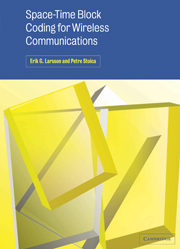Book contents
- Frontmatter
- Contents
- ABOUT THE AUTHORS
- PREFACE
- NOTATION
- COMMONLY USED SYMBOLS
- ABBREVIATIONS
- 1 INTRODUCTION
- 2 THE TIME-INVARIANT LINEAR MIMO CHANNEL
- 3 MIMO INFORMATION THEORY
- 4 ERROR PROBABILITY ANALYSIS
- 5 RECEIVE DIVERSITY
- 6 TRANSMIT DIVERSITY AND SPACE-TIME CODING
- 7 LINEAR STBC FOR FLAT FADING CHANNELS
- 8 LINEAR STBC FOR FREQUENCY-SELECTIVE CHANNELS
- 9 COHERENT AND NON-COHERENT RECEIVERS
- 10 SPACE-TIME CODING FOR INFORMED TRANSMITTERS
- 11 SPACE-TIME CODING IN A MULTIUSER ENVIRONMENT
- A SELECTED MATHEMATICAL BACKGROUND MATERIAL
- B THE THEORY OF AMICABLE ORTHOGONAL DESIGNS
- REFERENCES
- INDEX
11 - SPACE-TIME CODING IN A MULTIUSER ENVIRONMENT
Published online by Cambridge University Press: 31 October 2009
- Frontmatter
- Contents
- ABOUT THE AUTHORS
- PREFACE
- NOTATION
- COMMONLY USED SYMBOLS
- ABBREVIATIONS
- 1 INTRODUCTION
- 2 THE TIME-INVARIANT LINEAR MIMO CHANNEL
- 3 MIMO INFORMATION THEORY
- 4 ERROR PROBABILITY ANALYSIS
- 5 RECEIVE DIVERSITY
- 6 TRANSMIT DIVERSITY AND SPACE-TIME CODING
- 7 LINEAR STBC FOR FLAT FADING CHANNELS
- 8 LINEAR STBC FOR FREQUENCY-SELECTIVE CHANNELS
- 9 COHERENT AND NON-COHERENT RECEIVERS
- 10 SPACE-TIME CODING FOR INFORMED TRANSMITTERS
- 11 SPACE-TIME CODING IN A MULTIUSER ENVIRONMENT
- A SELECTED MATHEMATICAL BACKGROUND MATERIAL
- B THE THEORY OF AMICABLE ORTHOGONAL DESIGNS
- REFERENCES
- INDEX
Summary
This short chapter is aimed at highlighting some issues related to the use of space-time coding in a multiuser environment. We will see that in general, the use of a space-time code changes the statistical properties of the transmitted signal compared with conventional transmission. We will also describe some simple techniques for multiuser interference suppression in a system that uses orthogonal STBC.
Introduction
Since the radio spectrum is a finite resource, the radio frequencies will always be shared. For this reason, all users in a system will suffer from co-channel interference, that is, disturbing radio signals from other users who use the same carrier frequency. The capacity of a system is related to how often, or how densely, the carrier frequencies are reused in the system. The more densely the frequencies are used, the higher the system capacity, but also the higher the level of co-channel interference. Therefore a signal processing algorithm that can suppress co-channel interference at the receiver, or maintain a functional communication link at a higher interference level, can also increase the system capacity. In a cellular system, the sharing of frequencies is usually coordinated by the network, whereas for some indoor local area networks, and so-called ad-hoc networks, it may be harder to assign radio resources in a coordinated manner; consequently the problem of mitigating co-channel interference may be even more important for such networks.
- Type
- Chapter
- Information
- Space-Time Block Coding for Wireless Communications , pp. 223 - 234Publisher: Cambridge University PressPrint publication year: 2003



